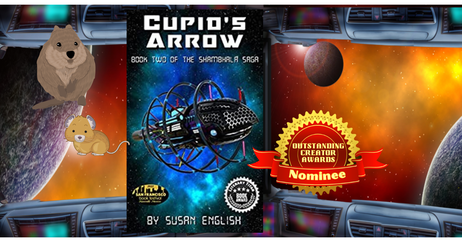|
Score: 87/100 (8.7 out of 10)
Cupid's Arrow is the second book in the Shambhala Saga by Susan English, a series that seems to mirror the author's own incredible real-life journey in the Peace Corps. The book follows a number of mostly-female and gender fluid characters, chief of which is Pavani, the love of interest of Callisto (Calli) in the previous novel. Although this book overlaps several genres and sub-genres like science-fiction, space marines, space colonization, and space operas, this book seems to be largely an LGBTQ+, feminist romantic drama with a sprinkling of sci-fi elements. We've seen some great LGBTQ+ and feminist books come our way including Bacon Grief by Joel Shoemaker (arguably the funniest book we've ever read), Valiente by A.G. Castillo (one of the best sports novels we've ever read), THAW by A.C. Kabukuru (former winner in science-fiction), and My Famous Brain by Diane Wald (with a gay character who won our “Best Supporting Character” award and an interesting plot). So, that's not an issue at all. In fact, it adds to the uniqueness. With that said, there seems to be something...off or lacking with this particular book in our opinion. We weren't as entertained or engaged as we wanted to be. That might just be us, who knows. But we can only speak honestly and from our perspective. It felt like nothing significant was happening most of the time. Pavani's longing and quest to be reunited with Castillo is relegated to the back-end of the book, long after we'd started losing interest. Perhaps the one quote from this book that summarized our feelings most of the time is: “...were we in junior high? Some things never change.” That quote spoke to us the most. It was the way we felt about the characters and their struggles. They seem to be acting like immature, love-drunk teenagers with the intelligence of the cast of Big Bang Theory. Meanwhile, there didn't seem to be a strong or clear over-arching plot or villain and the book got stuck in the weeds. Here are a list of characters from the novel: Pavani, Naomi, Diana, Izumi, Hiroki, Annie, Max, Simon, Sasha, Nalah, Fatima, Rika, Yuri, Raven, Asha, General Khoza, Yasmin, Akari, and Sook (to name a few). These characters just seem to get thrown at you with little to no explanation of who they are or if they're important enough for you to remember their names. From what we gather, Pavani is the main character and the prospective we take, Naomi is a mad scientist/botanist/zoologist trying to clone extinct things Jurassic-Park-style, Fatima is a soldier and is tough and stuff, Nalah is around a lot and says stuff occasionally to provide exposition, Izumi & Diana are being wrongly accused of being bioterrorists by a clearly-evil government called the World Government that is sidelined for most of the book, and Hiroki owns a media outlet called SMC and seems to be up to no good in the neighborhood. So, a lot is actually happening, just none of it seems coherent to us. We don't know what parts are relevant to the other parts. It's like the parts don't feel like they work together. It feels like the author just really liked raisins and decided to put it in the chocolate chip cookie mix or the rice for the heck of it. That may not be the case, but it just feels that way. It's really hard to describe. Perhaps the whole problem we have stems from not being able to read the first book, Castillo 2.0, first. That'll do it. This book seems to lean on the idea that you've already read the previous one, which isn't the case because this one was submitted first. However, even then, we found ourselves not feeling like this book had a clear direction. One minute, the characters are having will-they/won't-they discussions like this is some werebear shapeshifter romance, then the next minute, they're talking about warp-drives or Hiroki's mystery or anthrax or 3D-printing quokkas. We're not exaggerating, that's literally how this book jumps from one thing to another thing to another thing. And it just doesn't seem to mesh or mix. We were just dying for the author to focus on one main thing, but we kept having side-quests. The most egregious of these side-quests is definitely the 3D printing/cloning of the pikas (little mountain mammals that look like gofers) and later quokkas. So much time is spent on this subplot with Pavani coming in and out of the lab to see the progress and have a chat. It's a bit much. Yes, it does have a higher meaning in that it warns us what could happen if we don't conserve the environment and protect the planet. The extinction of beautiful creatures due to humanity's negligence and abuse is a very real possibility. We have to admit something: the pika subplot was probably our favorite part of the book. We personally got a bit attached to the cute little buggers and wanted to see them thrive and do well. This book does have a lot to offer and a lot to say about humanity, death, gender, the environment, and a whole lot of other things. You can check it out on Amazon!
0 Comments
Leave a Reply. |
Archives
July 2024
Categories |

 RSS Feed
RSS Feed